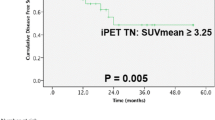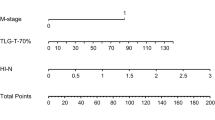Abstract
Purpose
To investigate the predictive value of pretherapeutic metabolic tumor imaging using 18-fluorodeoxyglucose positron emission tomography (FDG-PET) for regional response in oropharyngeal cancer patients undergoing primary (chemo)radiation.
Methods
Retrospective analysis of oropharyngeal cancer patients treated with primary (chemo)radiation at the University Hospital Zurich from 2010 to 2019 with available FDG-PET. The SUVmax of the largest lymph node metastases was recorded. Regional response was assessed using posttherapeutic FDG-PET at 12 weeks and regional recurrence-free survival.
Results
95 patients with a mean age of 68.5 years (SD 10.3) were included. The median pretherapeutic nodal SUVmax was 8.3 (interquartile range 4.4–13.3). A pretherapeutic nodal SUVmax above 6 significantly predicted poorer regional recurrence-free survival (log-rank test, P = 0.009) in univariate analysis. However, in multivariate analysis SUVmax above 6 was not significant in predicting regional recurrence-free survival (Cox regression P = 0.189). Clinical N category showed a trend in which a more severe stage had a poorer regional survival (Cox regression P = 0.073).
Conclusion
The SUVmax of the largest lymph node metastasis seems to play a role in predicting regional response in oropharyngeal cancer patients, after stratifying for N category. More research is needed to investigate whether highly metabolically active disease is less likely to respond to chemoradiation.






Similar content being viewed by others
References
Dhull AK, Atri R, Dhankhar R, Chauhan AK, Kaushal V (2018) Major risk factors in head and neck Cancer: a retrospective analysis of 12-year experiences. World J Oncol 9(3):80
Chaturvedi AK, Engels EA, Pfeiffer RM, Hernandez BY, Xiao W, Kim E et al (2011) Human papillomavirus and rising oropharyngeal cancer incidence in the United States. J Clin Oncol 29(32):4294
Broglie MA, Jochum W, Michel A, Waterboer T, Foerbs D, Schoenegg R et al (2017) Evaluation of type-specific antibodies to high risk-human papillomavirus (HPV) proteins in patients with oropharyngeal cancer. Oral Oncol 70:43–50
Goldenberg D, Begum S, Westra WH, Khan Z, Sciubba J, Pai SI et al (2008) Cystic lymph node metastasis in patients with head and neck cancer: an HPV-associated phenomenon. Head Neck J Sci Spec Head Neck 30(7):898–903
Gillison ML, Trotti AM, Harris J, Eisbruch A, Harari PM, Adelstein DJ et al (2019) Radiotherapy plus cetuximab or cisplatin in human papillomavirus-positive oropharyngeal cancer (NRG Oncology RTOG 1016): a randomised, multicentre, non-inferiority trial. Lancet 393(10166):40–50
Broglie MA, Stoeckli SJ, Sauter R, Pasche P, Reinhard A, de Leval L et al (2017) Impact of human papillomavirus on outcome in patients with oropharyngeal cancer treated with primary surgery. Head Neck 39(10):2004–2015
Bernier J (2011) Head and neck cancer: multimodality management. Springer Science & Business Media
Grégoire V, Lefebvre J-L, Licitra L, Felip E (2010) Squamous cell carcinoma of the head and neck: EHNS–ESMO–ESTRO clinical practice guidelines for diagnosis, treatment and follow-up. Ann Oncol 21(suppl5):184–186
Tupchong L, Phil D, Scott CB, Blitzer PH, Marcial VA, Lowry LD et al (1991) Randomized study of preoperative versus postoperative radiation therapy in advanced head and neck carcinoma: long-term follow-up of RTOG study 73–03. Int J Radiat Oncol Biol Phys 20(1):21–28
Rüegg P, Morand GB, Kudura K, Rupp NJ, Hüllner MW, Broglie MA (2020) Tumor cell viability in salvage neck dissections: Poor prognosis predicted by high postradiation nodal SUVmax, p16-negativity, and low nodal shrinkage. Head Neck 42(4):660–669
Kyzas PA, Evangelou E, Denaxa-Kyza D, Ioannidis JP (2008) 18F-fluorodeoxyglucose positron emission tomography to evaluate cervical node metastases in patients with head and neck squamous cell carcinoma: a meta-analysis. J Natl Cancer Inst 100(10):712–720
Lim RS, Ramdave S, Beech P, Billah B, Karim MN, Smith JA et al (2016) Utility of SUV max on 18 F-FDG PET in detecting cervical nodal metastases. Cancer Imaging 16(1):39
Fleming AJ Jr, Smith SP Jr, Paul CM, Hall NC, Daly BT, Agrawal A et al (2007) Impact of [18F]-2-fluorodeoxyglucose–positron emission tomography/computed tomography on previously untreated head and neck cancer patients. Laryngoscope 117(7):1173–1179
Cacicedo J, Navarro A, Del Hoyo O, Gomez-Iturriaga A, Alongi F, Medina JA et al (2016) Role of fluorine-18 fluorodeoxyglucose PET/CT in head and neck oncology: the point of view of the radiation oncologist. Br J Radiol 89(1067):20160217
Stalder SA, Schumann P, Lanzer M, Hüllner MW, Rupp NJ, Broglie MA et al (2020) Value of SUVmax for the prediction of bone invasion in oral squamous cell carcinoma. Biology 9(2):23
Werner J, Hüllner MW, Rupp NJ, Huber AM, Broglie MA, Huber GF et al (2019) Predictive value of pretherapeutic maximum standardized uptake value (Suv max) in laryngeal and hypopharyngeal cancer. Sci Rep 9(1):1–10
Morand GB, Vital DG, Kudura K, Werner J, Stoeckli SJ, Huber GF et al (2018) Maximum standardized uptake value (SUV max) of primary tumor predicts occult neck metastasis in oral cancer. Sci Rep 8(1):1–7
Bredell MG, Ernst J, El-Kochairi I, Dahlem Y, Ikenberg K, Schumann DM (2016) Current relevance of hypoxia in head and neck cancer. Oncotarget 7(31):50781
Wilson WR, Hay MP (2011) Targeting hypoxia in cancer therapy. Nat Rev Cancer 11(6):393–410
Brizel DM, Sibley GS, Prosnitz LR, Scher RL, Dewhirst MW (1997) Tumor hypoxia adversely affects the prognosis of carcinoma of the head and neck. Int J Radiat Oncol Biol Phys 38(2):285–289
Mehanna H, Wong W-L, McConkey CC, Rahman JK, Robinson M, Hartley AG et al (2016) PET-CT surveillance versus neck dissection in advanced head and neck cancer. N Engl J Med 374(15):1444–1454
Schwartz DL, Rajendran J, Yueh B, Coltrera MD, LeBlanc M, Eary J et al (2004) FDG-PET prediction of head and neck squamous cell cancer outcomes. Arch Otolaryngol Head Neck Surg 130(12):1361–1367
Liao CT, Chang JTC, Wang HM, Ng SH, Hsueh C, Lee LY et al (2009) Preoperative [18F] fluorodeoxyglucose positron emission tomography standardized uptake value of neck lymph nodes predicts neck cancer control and survival rates in patients with oral cavity squamous cell carcinoma and pathologically positive lymph nodes. Int J Radiat Oncol Biol Phys 74(4):1054–1061
Haerle SK, Strobel K, Ahmad N, Soltermann A, Schmid DT, Stoeckli SJ (2011) Contrast-enhanced 18F-FDG-PET/CT for the assessment of necrotic lymph node metastases. Head Neck 33(3):324–329
Guenzel T, Franzen A, Wiegand S, Kraetschmer S, Jahn JL, Mironczuk R et al (2013) The value of PET compared to MRI in malignant head and neck tumors. Anticancer Res 33(3):1141–1146
Hoang JK, Vanka J, Ludwig BJ, Glastonbury CM (2013) Evaluation of cervical lymph nodes in head and neck cancer with CT and MRI: tips, traps, and a systematic approach. Am J Roentgenol 200(1):W17–W25
Smeets SJ, Hesselink AT, Speel EJM, Haesevoets A, Snijders PJ, Pawlita M et al (2007) A novel algorithm for reliable detection of human papillomavirus in paraffin embedded head and neck cancer specimen. Int J Cancer 121(11):2465–2472
Sekine T, Delso G, Zeimpekis KG, de Galiza BF, Ter Voert EE, Huellner M et al (2018) Reduction of 18F-FDG dose in clinical PET/MR imaging by using silicon photomultiplier detectors. Radiology 286(1):249–259
Sekine T, de Galiza BF, Kuhn FP, Burger IA, Stolzmann P, Huber GF et al (2017) PET+ MR versus PET/CT in the initial staging of head and neck cancer, using a trimodality PET/CT+ MR system. Clin Imaging 42:232–239
Queiroz MA, Huellner MW (2015) PET/MR in cancers of the head and neck. Seminars in nuclear medicine. Elsevier, Amsterdam
Marcus C, Ciarallo A, Tahari AK, Mena E, Koch W, Wahl RL et al (2014) Head and neck PET/CT: therapy response interpretation criteria (Hopkins criteria)—interreader reliability, accuracy, and survival outcomes. J Nucl Med 55(9):1411–1416
Castelli J, De Bari B, Depeursinge A, Simon A, Devillers A, Jimenez GR et al (2016) Overview of the predictive value of quantitative 18 FDG PET in head and neck cancer treated with chemoradiotherapy. Crit Rev Oncol Hematol 108:40–51
Schrepfer T, Haerle SK, Strobel K, Schaefer N, Hälg RA, Huber GF (2010) The value of 18F-fluorodeoxyglucose positron emission tomography/computed tomography for staging of primary extranodal head and neck lymphomas. Laryngoscope 120(5):937–944
Kubicek GJ, Champ C, Fogh S, Wang F, Reddy E, Intenzo C et al (2010) FDG-PET staging and importance of lymph node SUV in head and neck cancer. Head Neck Oncol 2(1):19
Liao CT, Chang JTC, Wang HM, Ng SH, Huang SF, Chen IH et al (2009) Preoperative [18 F]-fluorodeoxyglucose positron emission tomography standardized uptake value of neck lymph nodes may aid in selecting patients with oral cavity squamous cell carcinoma for salvage therapy after relapse. Eur J Nucl Med Mol Imaging 36(11):1783
Schwartz DL, Harris J, Yao M, Rosenthal DI, Opanowski A, Levering A et al (2015) Metabolic tumor volume as a prognostic imaging-based biomarker for head-and-neck cancer: pilot results from Radiation Therapy Oncology Group protocol 0522. Int J Radiat Oncol Biol Phys 91(4):721–729
Inokuchi H, Kodaira T, Tachibana H, Nakamura T, Tomita N, Nakahara R et al (2011) Clinical usefulness of [(18) F] fluoro-2-deoxy-D-glucose uptake in 178 head-and-neck cancer patients with nodal metastasis treated with definitive chemoradiotherapy: consideration of its prognostic value and ability to provide guidance for optimal selection of patients for planned neck dissection. Int J Radiat Oncol Biol Phys 79(3):747–755
Shaw RJ, Lowe D, Woolgar JA, Brown JS, Vaughan ED, Evans C et al (2010) Extracapsular spread in oral squamous cell carcinoma. Head Neck J Sci Spec Head Neck 32(6):714–722
Benchetrit L, Torabi SJ, Givi B, Haughey B, Judson BL (2021) Prognostic significance of extranodal extension in HPV-mediated oropharyngeal carcinoma: a systematic review and meta-analysis. Otolaryngol Head Neck Surg 164(4):720–732
Mermod M, Tolstonog G, Simon C, Monnier Y (2016) Extracapsular spread in head and neck squamous cell carcinoma: a systematic review and meta-analysis. Oral Oncol 62:60–71
Clark J, Jeffery CC, Zhang H, Cooper T, O’Connell DA, Harris J et al (2015) Correlation of PET-CT nodal SUVmax with p16 positivity in oropharyngeal squamous cell carcinoma. J Otolaryngol Head Neck Surg 44(1):37
Yousem DM, Som PM, Hackney DB, Schwaibold F, Hendrix RA (1992) Central nodal necrosis and extracapsular neoplastic spread in cervical lymph nodes: MR imaging versus CT. Radiology 182(3):753–759
Som PM (1987) Lymph nodes of the neck. Radiology 165(3):593–600
Deron P, Vangestel C, Goethals I, De Potter A, Peeters M, Vermeersch H et al (2011) FDG uptake in primary squamous cell carcinoma of the head and neck. Nuklearmedizin 50(01):15–21
Zhen W, Karnell LH, Hoffman HT, Funk GF, Buatti JM, Menck HR (2004) The National Cancer Data Base report on squamous cell carcinoma of the base of tongue. Head Neck J Sci Spec Head Neck 26(8):660–674
Kamran SC, Qureshi MM, Jalisi S, Salama A, Grillone G, Truong MT (2018) Primary surgery versus primary radiation-based treatment for locally advanced oropharyngeal cancer. Laryngoscope 128(6):1353–1364
Wuerdemann N, Wittekindt C, Sharma SJ, Prigge E-S, Reuschenbach M, Gattenlöhner S et al (2017) Risk factors for overall survival outcome in surgically treated human papillomavirus-negative and positive patients with oropharyngeal cancer. Oncol Res Treat 40(6):320–327
Schache AG, Liloglou T, Risk JM, Filia A, Jones TM, Sheard J et al (2011) Evaluation of human papilloma virus diagnostic testing in oropharyngeal squamous cell carcinoma: sensitivity, specificity, and prognostic discrimination. Clin Cancer Res 17(19):6262–6271
Author information
Authors and Affiliations
Corresponding author
Additional information
Publisher's Note
Springer Nature remains neutral with regard to jurisdictional claims in published maps and institutional affiliations.
Rights and permissions
About this article
Cite this article
Lekanne dit Deprez, L.W., Morand, G.B., Thüring, C. et al. SUVmax for predicting regional control in oropharyngeal cancer. Eur Arch Otorhinolaryngol 279, 3167–3177 (2022). https://doi.org/10.1007/s00405-021-07169-7
Received:
Accepted:
Published:
Issue Date:
DOI: https://doi.org/10.1007/s00405-021-07169-7




